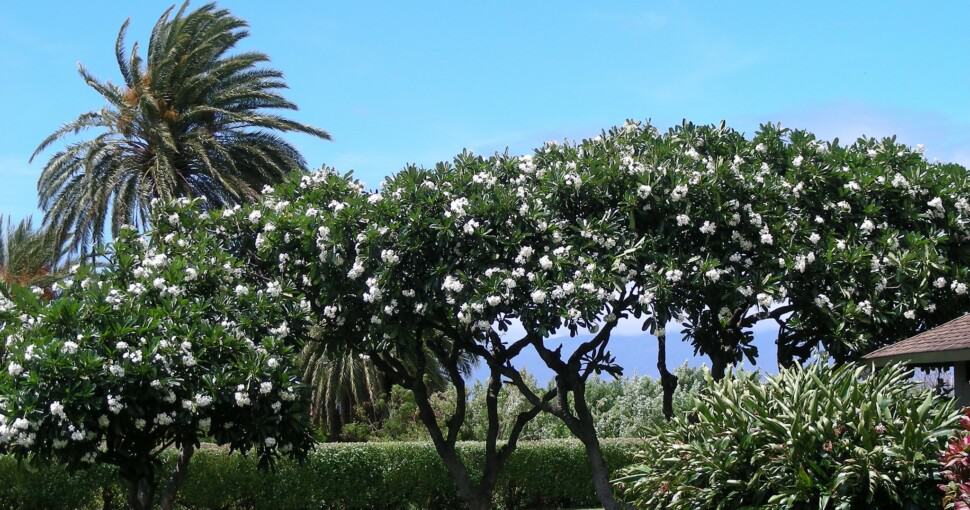Plumeria is a tree that bears exquisite flowers, often known as the Hawaiian Lei flower. Oil from the flowers has been used since the sixteenth century to produce perfumes. It is the national flower of Nicaragua and the floral emblem of Palermo in Sicily.
Plumeria is frequently called by its common name Frangipani. The name plumeria was given to honor the French botanist Charles Plumier who first documented it. The name Frangipani comes from the Italian Marquis Frangipani, who created perfume using the flower oils.
Plumeria occurs naturally in Mexico, Venezuela, Colombia, and other Central American countries. It has been a popular garden plant for centuries due to its visual appeal and enticing scent, which is strongest at night. As a result, plumeria has become naturalized in areas such as Hawaii, where many people think it is indigenous.
Plumeria grows as a small to medium tree, reaching heights of sixteen to twenty feet. It has a thick fleshy stem similar to a succulent that leads into multiple branches. The bark is greyish-green. The plant leaks a milky sap if it is cut or damaged.
Leaves grow from the ends of the branches, and their appearance varies according to the cultivar. Some are narrow and corrugated, and others are broad, elongated, and glossy. The leaf color can differ from silvery green to intense green or dark green.
Plumeria flowers bud at the end of the branches in clusters in late spring or early summer. The buds open into five-petalled flowers that have a waxy appearance. The flowers typically have two colors: white with a yellow center or pink with an orange-yellow center. The blossoms may be pink, creamy white, yellow, wine red, or apricot.
1. Gardenia
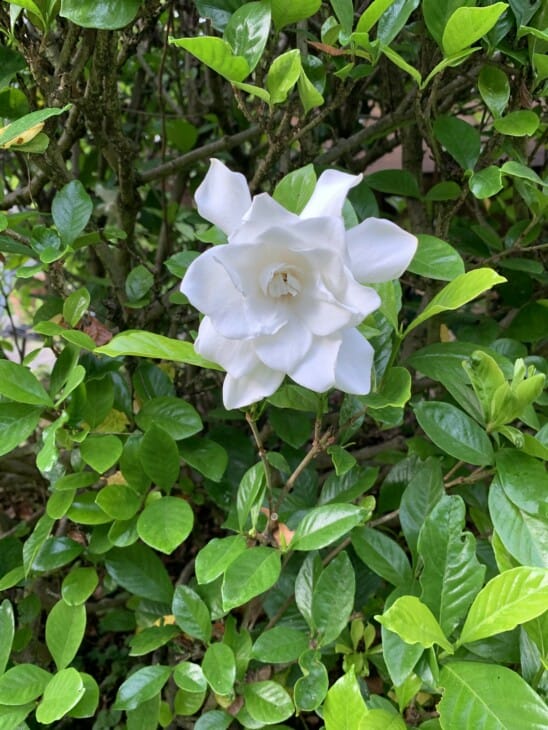
Gardenias belong to the Rubiaceae or coffee plant family. They are classed as shrubs or small trees and can grow from three to fifty feet tall. Gardenias grow naturally in Africa, Madagascar, Asia, Australia, and the Pacific Islands.
They are evergreen, unlike plumeria, making them a good alternative if the garden needs shade or color throughout the year. The leaves are broad, dark green, and leathery, an attractive foliage addition to any garden. The leaves may be arranged oppositely or in whorls around the stem.
The flowers appear singly or in small clusters. Gardenia flowers, like plumeria, are waxy and have a strong pleasant fragrance. They are white or yellow, and their appearance differs according to the cultivar.
Some gardenias may have a simple 5-petalled star-like flower, and some may have overlapping petals like plumeria. Other gardenia cultivars have more complex flowers with many petals, similar to roses.
Gardenias have varying cultivation needs depending on where they originate. Generally, though, they need a warmer climate, with moderate to high humidity and abundant rainfall. They can be grown indoors, but the plants are usually smaller.
Gardenias prefer slightly acidic soil. Special gardenia potting soil can be used for gardenias grown indoors. They grow in full sun, but in very hot climates, they do better in the morning sun with afternoon shade.
2. Jasmine
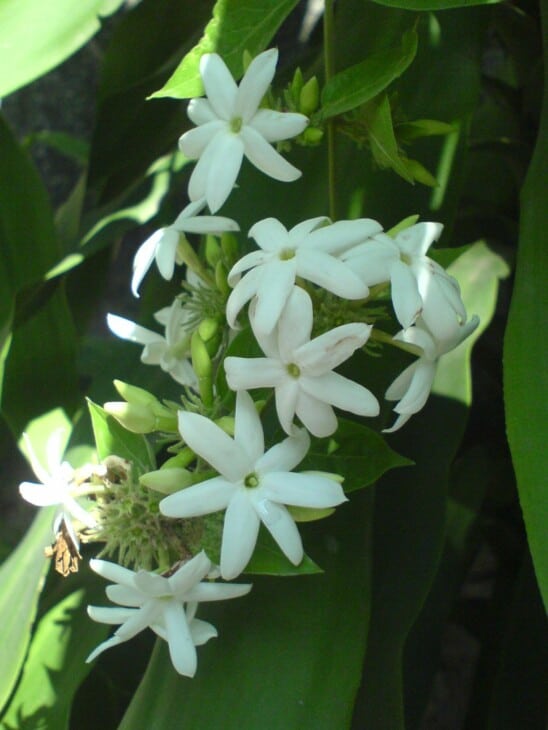
Jasmine is part of the Oleaceae or olive family. It is sometimes known as Jessamine, and it comes from the Persian word Yasmin, which translates to a gift from God. Jasmine is indigenous to warm subtropical or tropical regions of Africa, Europe, Asia, and Oceania. Damascus is sometimes called the City of Jasmine.
There are more than three hundred species of jasmine. Some grow as climbers, and others grow as shrubs or ground cover. Jasmine can be pruned to determine the growth pattern.
Like plumeria, jasmine has sweet, fragrant blooms, which are usually white or yellow. The flowers grow in large clusters, enhancing the scent. Their appearance varies according to the species, with petals numbering between four and nine. As the flowers die back, small berries form, which blacken as they ripen.
Most jasmine do not survive extensive frosts. Chinese jasmine (Jasminum polyanthum), winter jasmine (Jasminum nudiflorum), and Stephan’s jasmine (Jasminum stephanense) can tolerate temperatures below freezing. Jasmine grows well in pots, and gardeners living in climates with cold winters can move their plants in and outdoors as the weather dictates.
Well-drained soil rich in organic matter is the best growing medium for jasmine. The leaves are mostly bright green and can be simple or contain two or more leaflets. Jasmine may be evergreen or deciduous, depending on the species and the climate.
3. Philadelphus
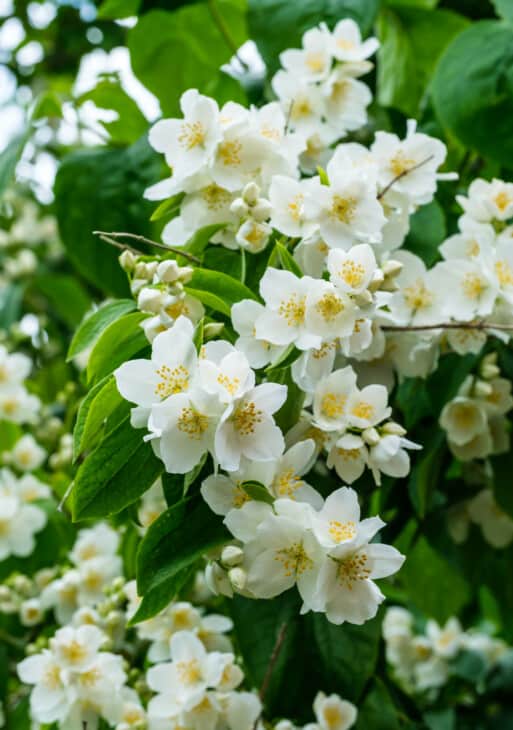
Philadelphus is better known by its colloquial name, mock orange. There are approximately sixty species of mock orange, and they belong to the family Hydrangeaceae.
Philadelphus are indigenous to southeastern Europe, Turkey, Greece, Albania, Libya, Lebanon, Northern America, and Central America. Mock orange is a shrub of ten to twelve feet tall, making it a good alternative to plumeria.
Most Philadelphus species are deciduous, but some species that grow closer to the equator are evergreen. Mock orange has straight, rigid branches that grow upwards. The bark peels off in strips, revealing pale brown bark, creating an easily identifiable pattern.
The oval leaves are usually a rich dark green and have serrated margins. They vary in size from half an inch to six inches.
Mock orange shrubs have white flowers similar to plumeria. The flowers are strongly scented with a fragrance reminiscent of oranges and jasmine. The flowers bloom in late spring or early summer. They die off after a short season, but new blossoms can be encouraged by lightly pruning the bush and removing the dead flowers.
Philadelphus plants grow best in full sun or dappled shade in moist soil with good drainage. They prefer sandy or loamy soil. Mock oranges can grow in chalk or clay soils, but the plants will be smaller, and clay soil will need additional organic material.
4. Nerium Oleander
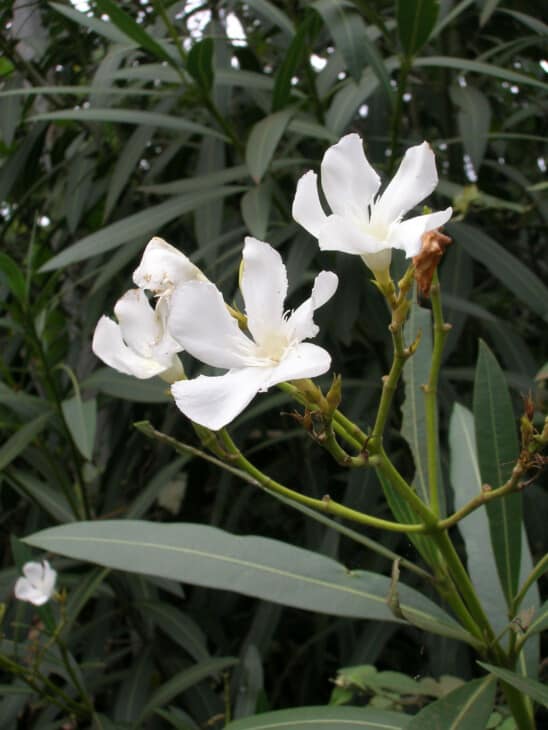
Nerium oleander, like plumeria, belongs to the Apocynaceae plant family. It is often referred to as oleander or Nerium. Oleander has been so widely cultivated and naturalized for many years that scientists can only guess that it originated in the Mediterranean Basin.
Oleander is a shrub or small tree, reaching heights of seven to twenty feet. All parts of the oleander are toxic, causing skin inflammation, eye irritation, gastrointestinal problems, and cardiac abnormalities, which can be fatal. The plant is very bitter, so ingestion of large amounts does not usually occur.
The new bark is light grey and darkens as it matures. Similarly, the leaves start as light glossy, green, and darken as they age. The leathery leaves grow in pairs or whorls of three. They are four to six inches long and less than half an inch wide, making them narrow leaves.
Oleander flowers are white, red, or pink. Some cultivars have a sweet scent, but many do not. The plant blooms throughout the year, but most flowers are produced during summer.
Nerium oleanders are easy to grow and tolerate some drought, but they cannot survive extended droughts.
5. Hibiscus
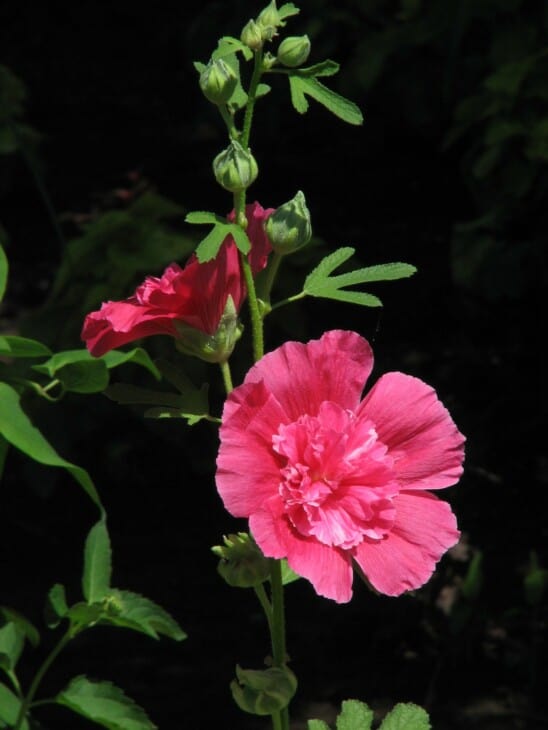
Hibiscus plants belong to the Malvaceae or mallow family. They are native to India and Malaysia, and there are hundreds of different species that grow as shrubs, trees, or herbs. Hibiscus shrubs are widely cultivated for their showy flowers, and many hybrids can be obtained.
Related: 8 Plants That Look Like Hibiscus | Are Hibiscus Plants Poisonous?
Hibiscus leaves are typically bright green with toothed margins. They are pear-shaped, with the veins making indentations on the leaf surface.
Hibiscus are best known for their large flowers, which can be found in many colors. Some hibiscus flowers are a single color, but numerous cultivars have a bright-colored flower center, making them very striking. The blooms are characterized by five petals with a large stamen.
Hibiscus plants grow best in tropical climates and are not frost-tolerant. They need regular watering and partial shade in very hot, dry climates.

